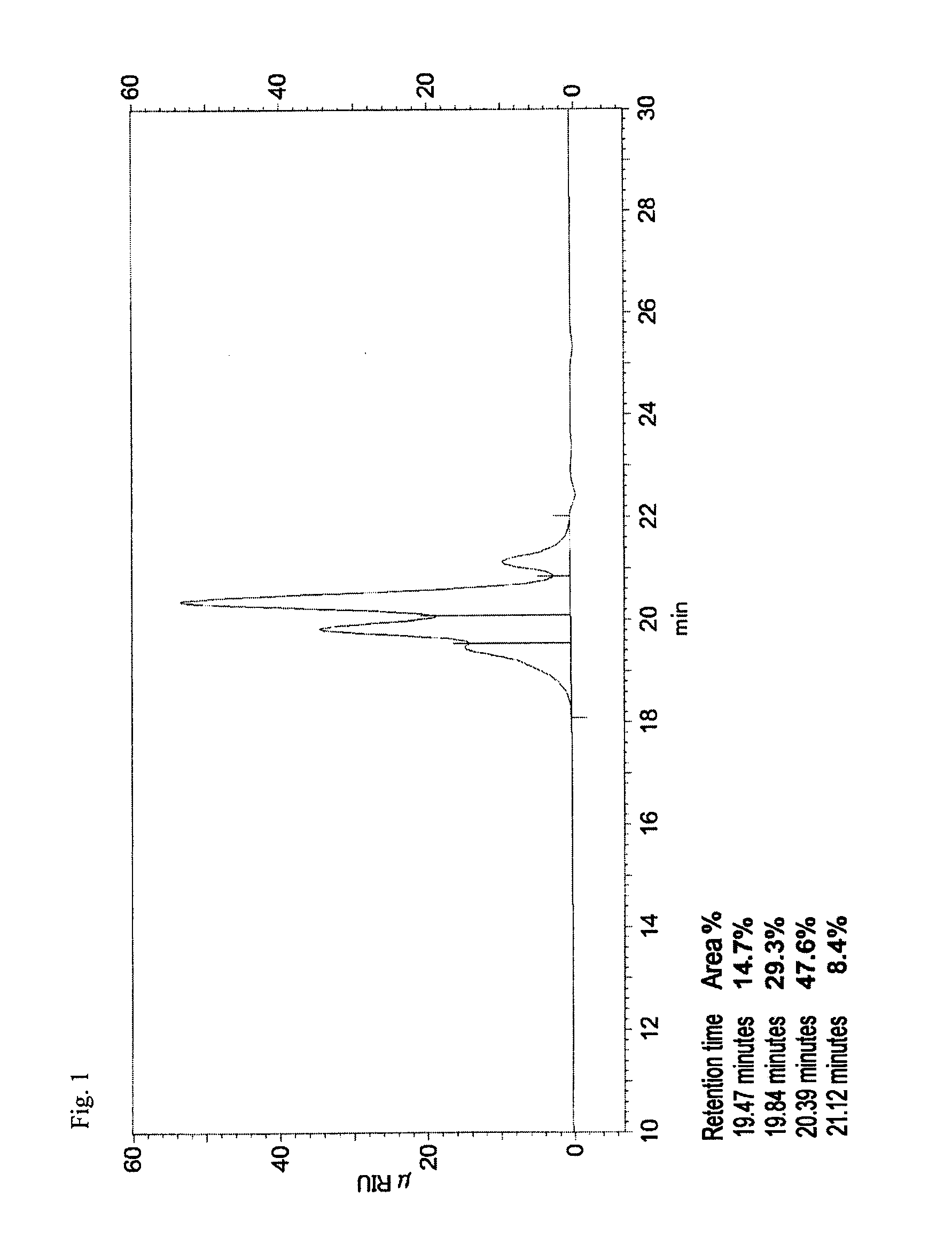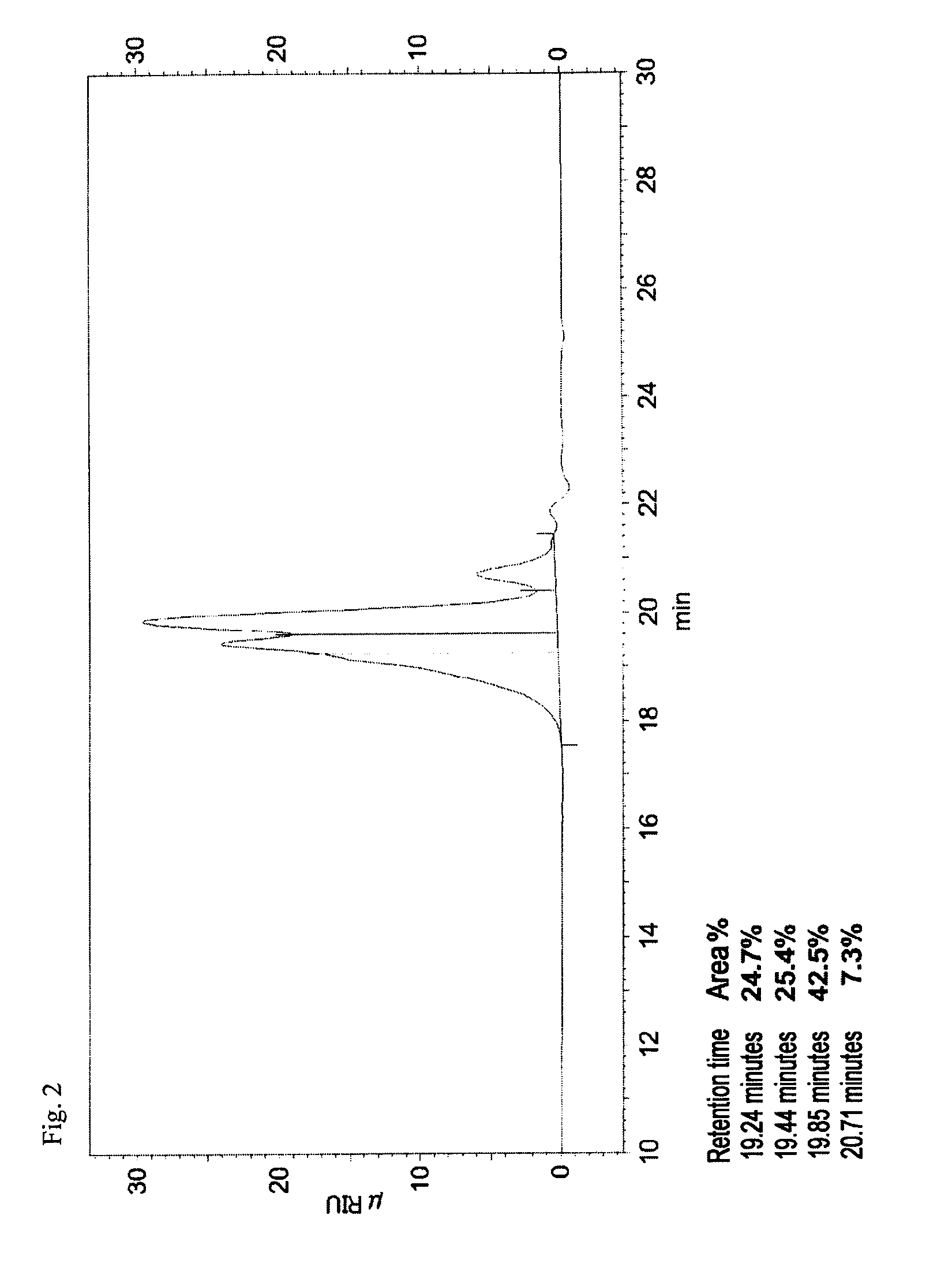Method for producing cyanogen-halide, cyanate ester compound and method for producing the same, and resin composition
a technology of cyanogen halide and ester compound, which is applied in the direction of inorganic chemistry, synthetic resin layered products, printing, etc., can solve the problems of warpage between a semiconductor chip and a substrate material, difficult control of reaction, and insufficient performance, etc., to achieve suppressed side reactions, high yield, and efficient production of cyanogen halide
- Summary
- Abstract
- Description
- Claims
- Application Information
AI Technical Summary
Benefits of technology
Problems solved by technology
Method used
Image
Examples
example 1
[0260]145.5 g (2.05 mol) of chlorine (manufactured by Fujiox Co., Ltd.) was blown into 1464 g of a 3.8%-by-mass aqueous solution of hydrogen cyanide (56.3 g (2.08 mol) of hydrogen cyanide and 1407.3 g of water), while keeping the liquid temperature at 0° C. to 5° C., under stirring over 7 hours. The used amount of the hydrogen cyanide was set at 1.0153 moles based on 1 mole of chlorine molecules. The pH of the reaction solution was less than 7. The reaction solution (40 g) obtained at the reaction terminal point was added to a water / dichloromethane solution (15 g / 10 g) cooled to 5° C., which had been prepared separately in advance, and the obtained mixture was then subjected to an extraction operation. As a result, both the dichloromethane phase and the water phase were colorless, and thus, it was confirmed that no unreacted chlorine molecules were present (the inversion percentage of the chlorine was 99.9% or more).
[0261]In addition, the ratio (A):(A)+(B) in the solution at the rea...
example 2
[0263]300 g (1.28 mol relative to OH group) of 1-naphthol aralkyl resin (manufactured by Nippon Steel & Sumikin Chemical Co., Ltd.) and 194.6 g (1.92 mol) of triethylamine (in an amount of 1.5 moles based on 1 mole of hydroxy group of the hydroxy group-substituted aromatic compound) were dissolved in 1800 g of dichloromethane, and the obtained solution was defined as solution 2.
[0264]The solution 2 was added dropwise to the solution 1 (in which the amount of a cyanogen chloride was 1.5 moles based on 1 mole of hydroxy group of the hydroxy group-substituted aromatic compound) (cyanogen halide solution e) under stirring, while keeping the liquid temperature at −2° C. to −0.5° C., over 30 minutes. After dropwise addition of the solution 2, the degree of reaction progress was 80.6%, and the dicyan concentration was 0.071% by mass. After completion of the dropwise addition of the solution 2, the reaction solution was stirred at the same temperature as described above for 30 minutes, and ...
example 3
[0267]32.3 g (0.65 mol) of 98%-by-mass sodium cyanide was dissolved in 128 g of water, and the obtained solution was defined as solution 4. The solution 4 was added dropwise to 91.2 g of a 36%-by-mass aqueous solution of hydrochloric acid (hydrochloric acid: 0.9 mol) (in an amount of 1.39 moles with respect to the sodium cyanide) and 317.7 g of water under stirring, while keeping the liquid temperature at −3° C. to −1° C., over 36 minutes. After completion of the dropwise addition of the solution 4, 45.4 g (0.64 mol) of chlorine (manufactured by Fujiox Co., Ltd.) was blown into the reaction solution, while keeping the liquid temperature at −2° C. to −1° C., over 3 hours. The amount of the sodium cyanide used was set at 1.0088 moles based on 1 mole of chlorine molecules. The pH of the reaction solution was less than 7. The reaction solution (40 g) obtained at the reaction terminal point was added to a water / dichloromethane solution (15 g / 10 g) cooled to 5° C., which had been prepared...
PUM
| Property | Measurement | Unit |
|---|---|---|
| Temperature | aaaaa | aaaaa |
| Temperature | aaaaa | aaaaa |
| Fraction | aaaaa | aaaaa |
Abstract
Description
Claims
Application Information
 Login to View More
Login to View More - R&D
- Intellectual Property
- Life Sciences
- Materials
- Tech Scout
- Unparalleled Data Quality
- Higher Quality Content
- 60% Fewer Hallucinations
Browse by: Latest US Patents, China's latest patents, Technical Efficacy Thesaurus, Application Domain, Technology Topic, Popular Technical Reports.
© 2025 PatSnap. All rights reserved.Legal|Privacy policy|Modern Slavery Act Transparency Statement|Sitemap|About US| Contact US: help@patsnap.com



